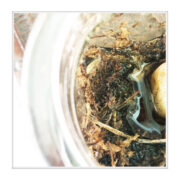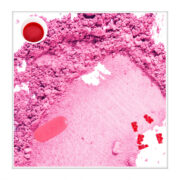Allergen.
Benzophenones:
2014’s Allergen of the Year by the American Contact Dermatitis Society, benzophenones are popular in several products because of their UV-absorbing properties. While their most obvious use might be in sunscreens, benzophenones are also used to protect lots of other things that might degrade due to light exposure, so you can find benzophenones in items as diverse as perfumes, lip balms, nail polish, hair dyes, hair sprays, shampoos, cleansers, creams, and other common cosmetics…to paints and varnishes…to inks, plastics, fabrics, and even circuit boards.
In addition to “benzophenones,”look for oxybenzone (2-hydroxy-4-methoxyphenyl), dioxybenzone (2,2-dihydroxy-4-methoxybenzophenone), mexenone (2-hydroxy-4-methoxy-4-methylbenzophenone), and sulisobenzone (2-hydroxy-4-methoxy benzophenone-5-sulfonic acid).
If you have a history of sensitive skin, don’t guess: random trial and error can cause more damage. Ask your dermatologist about a patch test.
References:
Regularly published reports on the most common allergens by the North American Contact Dermatitis Group and European Surveillance System on Contact Allergies (based on over 28,000 patch test results, combined), plus other studies. Remember, we are all individuals — just because an ingredient is not on the most common allergen lists does not mean you cannot be sensitive to it, or that it will not become an allergen. These references, being based on so many patch test results, are a good basis but it is always best to get a patch test yourself.
2. W Uter et al. The European Baseline Series in 10 European Countries, 2005/2006–Results of the European Surveillance System on Contact Allergies (ESSCA). Contact Dermatitis 61 (1), 31-38.7 2009
3. Wetter, DA et al. Results of patch testing to personal care product allergens in a standard series and a supplemental cosmetic series: An analysis of 945 patients from the Mayo Clinic Contact Dermatitis Group, 2000-2007. J Am Acad Dermatol. 2010 Nov;63(5):789-98.
4. Verallo-Rowell VM. The validated hypoallergenic cosmetics rating system: its 30-year evolution and effect on the prevalence of cosmetic reactions. Dermatitis 2011 Apr; 22(2):80-97
5. Ruby Pawankar et al. World Health Organization. White Book on Allergy 2011-2012 Executive Summary.
6. Misery L et al. Sensitive skin in the American population: prevalence, clinical data, and role of the dermatologist. Int J Dermatol. 2011 Aug;50(8):961-7.
7. Warshaw EM1, Maibach HI, Taylor JS, Sasseville D, DeKoven JG, Zirwas MJ, Fransway AF, Mathias CG, Zug KA, DeLeo VA, Fowler JF Jr, Marks JG, Pratt MD, Storrs FJ, Belsito DV. North American contact dermatitis group patch test results: 2011-2012.Dermatitis. 2015 Jan-Feb;26(1):49-59.
8. Warshaw, E et al. Allergic patch test reactions associated with cosmetics: Retrospective analysis of cross-sectional data from the North American Contact Dermatitis Group, 2001-2004. J AmAcadDermatol 2009;60:23-38.
9. Foliaki S et al. Antibiotic use in infancy and symptoms of asthma, rhinoconjunctivitis, and eczema in children 6 and 7 years old: International Study of Asthma and Allergies in Childhood Phase III. J Allergy Clin Immunol. 2009 Nov;124(5):982-9.
10. Kei EF et al. Role of the gut microbiota in defining human health. Expert Rev Anti Infect Ther. 2010 Apr; 8(4): 435–454.
11. Thavagnanam S et al. A meta-analysis of the association between Caesarean section and childhood asthma. Clin Exp Allergy. 2008;38(4):629–633.
12. Marks JG, Belsito DV, DeLeo VA, et al. North American Contact Dermatitis Group patch-test results, 1998 to 2000. Am J Contact Dermat. 2003;14(2):59-62.
13. Warshaw EM, Belsito DV, Taylor JS, et al. North American Contact Dermatitis Group patch test results: 2009 to 2010. Dermatitis. 2013;24(2):50-99.
14. Liao C, Kannan K. Widespread occurrence of benzophenone-type UV light filters in personal care products from china and the united states: an assessment of human exposure. Environ Sci Technol. 2014;48(7):4103-4119.
15. Fisher AA. Sunscreen dermatitis: Part III—The benzophenones. Cutis. 1992;50(5):331-332.
16. Nedorost ST. Facial erythema as a result of benzophenone allergy. J Am Acad Dermatol. 2003;49(5 suppl):S259-S661.
For more:
On the prevalence of skin allergies, see Skin Allergies Are More Common Than Ever and One In Four Is Allergic to Common Skin Care And Cosmetic Ingredients.
To learn more about the VH-Rating System and hypoallergenicity, click here.




[…] Benzophenones […]
[…] allergen, is in rubber. Phone accessories may contain dyes (some of which are allergens), benzophenones (prevent degradation from light exposure), and other common contact […]